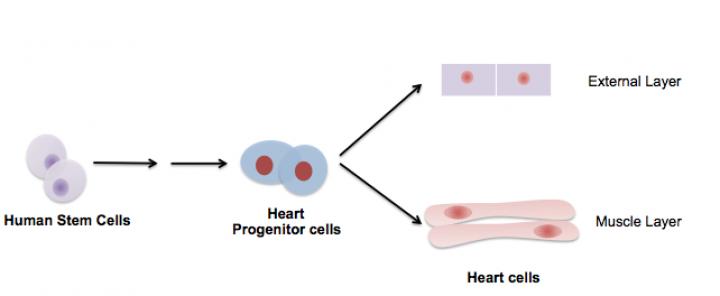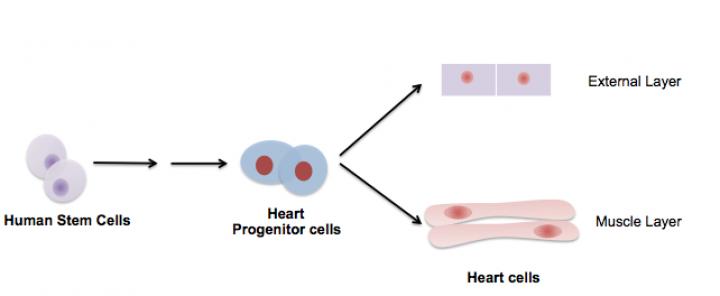
Credit: Lance Lian, Penn State
A process using human stem cells can generate the cells that cover the external surface of a human heart — epicardium cells — according to a multidisciplinary team of researchers.
"In 2012, we discovered that if we treated human stem cells with chemicals that sequentially activate and inhibit Wnt signaling pathway, they become myocardium muscle cells," said Xiaojun Lance Lian, assistant professor of biomedical engineering and biology, who is leading the study at Penn State. Myocardium, the middle of the heart's three layers, is the thick, muscular part that contracts to drive blood through the body.
The Wnt signaling pathway is a group of signal transduction pathways made of proteins that pass signals into a cell using cell-surface receptors.
"We needed to provide the cardiac progenitor cells with additional information in order for them to generate into epicardium cells, but prior to this study, we didn't know what that information was," said Lian. "Now, we know that if we activate the cells' Wnt signaling pathway again, we can re-drive these cardiac progenitor cells to become epicardium cells, instead of myocardium cells."
The group's results, published in Nature Biomedical Engineering, bring them one step closer to regenerating an entire heart wall. Through morphological assessment and functional assay, the researchers found that the generated epicardium cells were similar to epicardium cells in living humans and those grown in the laboratory.
"The last piece is turning cardiac progenitor cells to endocardium cells (the heart's inner layer), and we are making progress on that," said Lian.
The group's method of generating epicardium cells could be useful in clinical applications, for patients who suffer a heart attack. According to the Centers for Disease Control and Prevention, every 43 seconds, someone in the United States has a heart attack
"Heart attacks occur due to blockage of blood vessels," said Lian. "This blockage stops nutrients and oxygen from reaching the heart muscle, and muscle cells die. These muscle cells cannot regenerate themselves, so there is permanent damage, which can cause additional problems. These epicardium cells could be transplanted to the patient and potentially repair the damaged region."
During their study, the researchers engineered the human stem cells to become reporter cells, meaning these cells expressed a fluorescent protein only when they became epicardium cells.
"We treated the cells with different cell signaling molecules, and we found that when we treated them with Wnt signaling activators, they became fluorescent," said Lian.
Another finding, he said, is that in addition to generating the epicardium cells, the researchers also can keep them proliferating in the lab after treating these cells with a cell-signaling pathway Transforming Growth Factor Beta (TGF) inhibitor.
"After 50 days, our cells did not show any signs of decreased proliferation. However, the proliferation of the control cells without the TGF Beta inhibitor started to plateau after the tenth day," said Lian.
The team will continue working together to further their research on regenerating endocardium cells.
"We are making progress on that inner layer, which will allow us to regenerate an entire heart wall that can be used in tissue engineering for cardiac therapy," said Lian.
###
Additional researchers on this project include: Principal Investigator Sean P. Palecek, Milton J. and A. Maude Shoemaker Professor in the Department of Chemical and Biological Engineering; post-doctoral researcher Tongcheng Qian; graduate students Xiaoping Bao and Vijesh J. Bhute; and undergraduate research assistants Tianxiao Han and Mengxuan Shi, all from the University of Wisconsin, Madison; Timothy A. Hacker and Eric G. Schmuck, Department of Medicine, University of Wisconsin, Madison; Lauren Drowley, Alleyn T. Plowright and Qing-Dong Wang, Department of Cardiovascular and Metabolic Diseases Innovative Medicine Unit, AstraZeneca, Sweden; and Marie-Jose Goumans, Department of Molecular Cell Biology, Leiden University Medical Center, the Netherlands.
The National Institutes of Health, the National Science Foundation, Penn State's College of Engineering and the University of Wisconsin Stem Cell and Regenerative Medicine Center supported this work.
Media Contact
A'ndrea Elyse Messer
[email protected]
814-865-9481
@penn_state
http://live.psu.edu
############
Story Source: Materials provided by Scienmag





